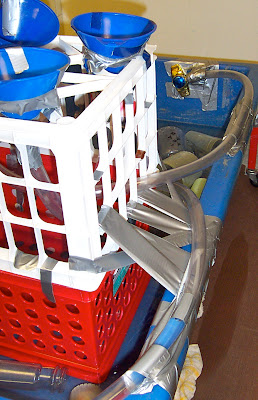Funnels, tubes and a whole lot of duct tape holding it all together. (If you look closely, I even incorporated a larger black tube, one that is not clear.)
One or two of the tubes empty into a large tub at one end of the table.
One or two of the tubes empty back into the table itself.
This is not a good picture showing the two tubes emptying back into the table. One of the tubes is sandwiched in between duct tape and a drinkable yoghurt container so the water squirts away from the crate. The second one has the red water about to come out.
And one of the tubes leads to a sprinkler head that empties back into the table.
I purposely thread the tubes in such a way that it is not obvious where the water comes out. For instance, a funnel on one corner of the apparatus can empty on the exact opposite side of the crate. That way, the children have to figure out where the water comes out when they pour water into one of the funnels. There are a couple ways of doing that. One, you can pour the water into a funnel and listen to where the water comes out. It can get a little tricky, though, because there is always a delay from pouring water into the funnel and water coming out, especially if the tube is one of the long ones. And besides, if more than one child is pouring into the funnels, the water is coming out in more than one place at the same time. A second way to figure the path of the water is to track it through the clear tubes. The children see the water better if it is colored. Either way, you can literally see the children working out which funnel empties where. When they do, it is a wonderful discovery.
I have made this apparatus several ways. The very first time I made it, I set the crate right in the table.
I learned from this first version that the end of the tubes where the water comes out have to be lower than the top of the funnels. If not, the water does not empty out of the tubes when you pour it in the funnels; the funnels just overflow. I taped this apparatus to the bottom of the table and then to the sides.
Later, I set a crate on top of a crate and taped the crates together and then taped the two crates to the side of the table. This gave me the height so water emptied from the tubes, but it used a lot of duct tape.
This year, I taped a tray in the table.
And then taped the crate to the tray.
I have often been asked if I have the children help build an apparatus like this. The question causes me to pause and think because I see children as builders---both literally and figuratively---of meaning and knowledge. One of the reasons I have not had the children help build is a bit selfish: it is one of my creative outlets. Another reason is because it would change the nature of the activity. When the children work on the apparatus they are figuring out how it works and discovering some of the laws governing the natural world. They are also discovering spaces and levels created by the apparatus. In that whole process, they make it their own and take their play into new and uncharted realms. However, you could still ask the question: Doesn't allowing the children to build lead to the same processes? I will indeed pause again and think about that a little more.
If you want to read how one teacher allows the children to build with a similar tube apparatus, check out Teacher Tom's (from Seattle) post called: Picking Them Off the Ground.











Wow! I'm so glad I found your blog (via Child Central Station)! Your ideas are fantastic!
ReplyDeleteThanks, Jessi. Hopefully you can find some ideas you can use and adapt.
ReplyDeleteHi - I love your ideas. I've been looking for a way to put together a water wall that is portable and easy for kids to change into their own design (over and over and over). I have an almost 7 year old I think would love to play with something like this.
ReplyDeleteI've about ended up doing the peg board/water bottle idea - but really like this tubing idea.... where do I get the tubing tho?
The week I had this up, some school age children visited my room. After the session, one of them said: "I got all wet, but it was totally worth it." What I found is that provisions and loose parts like loose funnels and tubing really encourages a lot of play for the older children. I get the tubes at a hardware store in the plumbing section.
Delete